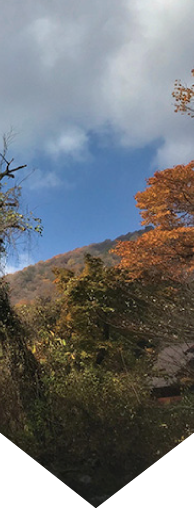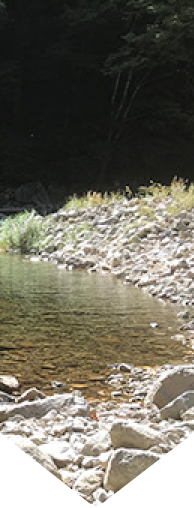The four seasons of Sandankyo
Sandankyo
Charter
Sandankyo
Sharply cut valleys, limpid water
Diverse plant and wildlife
The time has come to face the layers if history
One discovers the beauty of Mother Nature
Another paints a landscape portrait that blends into the scenery
One is impressed by the brave figure of a tiny living thing
One who notices the big contradiction lying in the gap between nature and humans
What do we consider beautiful?
What is it that we cherish?
And what should we do from now on?
Unaware, the line of sight will be pointed in our direction, inside of us
We will continue to face Sandankyo and its question
- The subtle and profound ravines ask us a question
The essence of the value of nature - The pure mountain stream asks us a question
The course of events between history and culture - The small path asks us a question
The connection between people
Establish 2017
(Sandankyo’s 100th anniversary)
Exploration One
The subtle and profound ravines ask us a question:
What is the true value of nature?
Sandankyo was designated as a national “scenic beauty” in 1925. A scenic beauty is a natural landscape that strongly reflects historical and humanistic aesthetics.
It can be seen from the literature of the time that the designation was based on the “literary tastes*” of the pre-modern era.
In 1953, it was designated as a “Special Place of Scenic Beauty” under the newly established Law for the Protection of Cultural Properties.
Nowadays, the unique climate and topography of the area make it an ideal place to visit.
In modern day, Sandankyo is recognized as a valley with a rich ecosystem full of precious species.
Sandankyo is a place where many values overlap, such as literary taste, natural beauty, and environmental conservation.
The value of Sandankyo has been created by the efforts of the people who have lived in harmony with its environment and strived to protect it.
Sandankyo is both a natural and cultural heritage. We will protect the beautiful scenery and the rich diversity of nature and nurture a sustainable environment for the next 100 years to come.
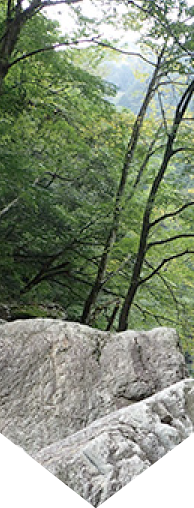
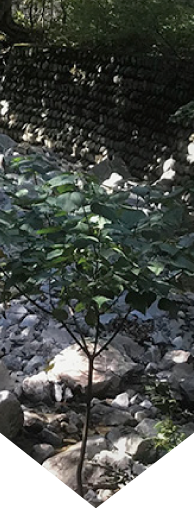
Exploration Two
The pure mountain stream asks us a question:
What is the relationship between history and culture?
The water from the rich forests of the West Chugoku Mountains flows into rivers and streams which support the people, creatures, and industries in the Ota River basin, before eventually pouring into the Seto Inland Sea.
The earth and sand carried by the Ota river formed the delta of Hiroshima, where houses were built with the timber harvested and transported via the river to create the city. Thus, people, goods, and culture were exchanged and distributed by using the river.
The iron produced with the Tatara iron making method, also known as Akijuri, flourished in the West Chugoku Mountains, and became one of Hiroshima’s main staple products. Its development laid the foundation for Hiroshima’s heavy iron industry in later years. The remains of charcoal kilns and Tatara fragments in Sandankyo remind us of the past when people cut down trees, burned charcoal, and made iron in this very area.
The upper reaches of the Ota River have a steep topography with narrow arable land and heavy snowfall, all of which lend to harsh living conditions. In such an environment, people were able to build sustainably and coexist with nature. We believe that this mountain village culture of living in harmony with nature has important implications for the future of our society.
Sandankyo is an open-air museum of the Ota River basin that leads to the sea. Its history is an inspiration to learn about the intimate relationship between man and nature, and about how to maintain the rich environment of the basin for the next 100 years.
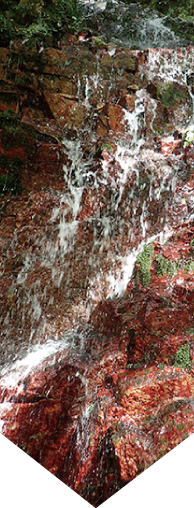
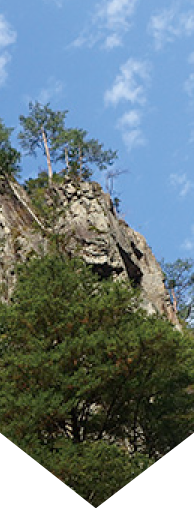
Exploration Three
The small path asks us a question:
How are we connected?
In 1917, photographer, Kuma Nanpo* entered the gorge for the first time. He was fascinated by the beauty of the valley and devoted himself to its cultural development.
With the help of elementary school teacher, Saito Rosui*, painter, Misawa Michihiko, and the local people, he was able to build a pathway through the 16km-long gorge.
The remaining scenic trails are designed to place as little burden on nature as possible while preserving the beauty of the area. Nanpo popularized the gorge through the publication of Sandankyo photo books and through a campaign promoting the gorge for designation as a scenic spot. He also proposed that the gorge be named to “Sandankyo” in reference to the similarly scenic natural views of China’s, “Three Gorges”.
It was Nanpo’s wish that this beautiful, painting-like landscape serve as a place of healing for people living in the city. Sandankyo Gorge attracted many people, and as the number of visitors increased, so did the number of local businesses.
Nanpo devoted his life to making Sandankyo a place where the warmth of mankind overlaps with the beauty and blessings of nature. His vision reflects the very goal of tourism aims to achieve.
Sandankyo is a common property for the enrichment and happiness of all visitors, and residents. We proudly take up Nanpo’s torch, striving to respect the environment and preserve Sandankyo for the next 100 years to come.
